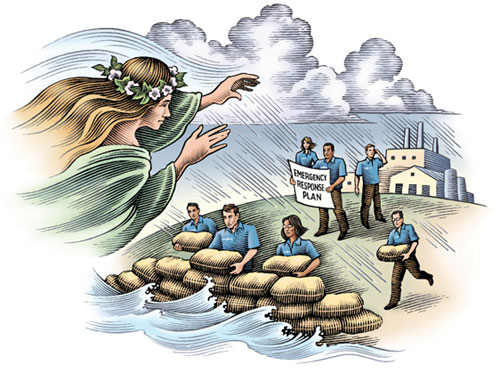Greensboro, North Carolina, USA
September 16, 2013
- Nature is unpredictable and ag professionals need to be prepared for severe weather events.
- Implementation of emergency plan at Syngenta plant in Omaha, Neb., provides example of steps to take to prevent storm damage.

This month, Humberto became the first hurricane of the 2013 Atlantic season. While the Category 1 storm posed no threat to the U.S., its presence serves as a reminder that ag professionals must always be prepared for what lies ahead.
Retailers, dealers and growers should have emergency plans in place to minimize damage and losses caused by hurricanes, tornadoes and floods. Allen Summers, president of the Asmark Institute, recommends that the possible scenarios be thought through carefully. “In a severe weather situation, people think they need a plan in place that relies on the fire department or the police—the community’s response mechanisms,” he said. “But those things may be working at a small percentage of full capacity. The advice we give is to look at what you can do to be self-sufficient.”
For example, in the spring of 2011, a record snowfall in Montana and Wyoming melted rapidly, raising the Missouri River 7 feet above flood levels, a once-in-500-year event. To contain the water, the Army Corps of Engineers shut the river’s valves, but that meant any rain that fell would have nowhere to go. The threat of major flooding was imminent in places like Omaha, Neb., so employees at the local Syngenta plant, situated in a low-lying valley, began developing an emergency plan. Existing plans addressed tornadoes and other disasters, but not floods, so they reached out to Syngenta plants in Greens Bayou, Texas, and St. Gabriel, La., which had well-developed hurricane plans, for insights into flood control. They then developed a plan for their specific situation, beginning with an incident command structure to detail everyone’s responsibilities.
“The incident command team brainstormed possible scenarios and what correct responses would look like,” said Bryce Danna, Omaha plant manager for Syngenta. “In each scenario, we identified decision points and wrote out the actions we would take if those points were reached.”
The plan also included internal and external emergency contacts and evacuation plans and routes. In all scenarios, the priorities remained constant: First protect people, then the environment, and then the assets and the production schedule.
An immediate concern of the incident command team was the need to build a sandbag berm around the plant—no small job for a 42-acre facility. Meanwhile, as a formulation site for Syngenta crop protection products, the Omaha plant had to maintain its production schedule. “We were protecting the facility, but we also had to deliver the business,” Tony Militti, Omaha maintenance engineer for Syngenta, said.
To implement the emergency plan, it was key for the team to have a firm grasp on the plant’s current inventory. “We had to understand exactly what materials we had and where they were, and then minimize storage requirements for them,” Danna added. “We emptied what we could and filled the tanks with water so they wouldn’t float away.”
With the help of the Syngenta regional office in Greensboro, N.C., the Omaha plant funnelled some production to other facilities. The regional office was able to help with procurement, too: Sandbags, pumps and trucks were hard to find around Omaha at that time.
Another challenge was to staff a 24/7 operation for the four months the flooding threat lasted. “People worked a lot of extra hours,” Danna says, “but they did it for the team.”
This team approach netted a win-win for Syngenta and its customers. “We missed no deliveries,” Militti said.
All contingencies need to be mapped out ahead of time, a lesson well learned in Omaha. “It pays huge dividends to be prepared,” Danna said. Now the Omaha employees have a thorough emergency response plan they use as a template. They review and update it annually, always adhering to that old, but wise adage: “Plan for the worst, hope for the best.”